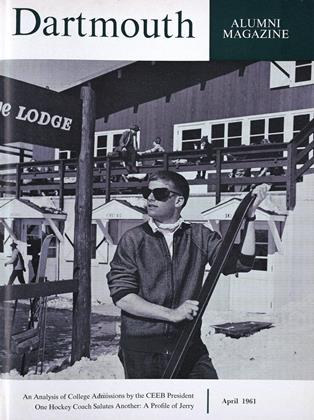Edited by Hadley Cantril '28.New Brunswick, New Jersey: RutgersUniversity Press, 1960. 236 pp. $6.00.
After graduation from Harvard College Adelbert Ames Jr. chose the profession of law, but was not satisfied with it. He claimed that he had no trouble with short briefs, but the long ones bothered him. Later he decided that this was caused by his aniseikonia, an eye condition which he discovered around 1928. He turned then to art and painting but was constantly bothered by the question "Why does an artist do this?" He expressed it this way: 1) Does an artist paint things as they actually are?; 2) does he paint them as he sees them?; or 3) does he paint them as he thinks he sees them? The answer to all these questions made Ames turn to the physics and optics of vision to determine the aberrations of lenses to show the different effects.
It was only a step to the psychology and physiology of vision and to binocular vision, and its related problems. All this work resulted in the formation of the Dartmouth Eye Institute with a group of forty resourceful and clinical people trained in the different fields of physiological optics. The work of the Dartmouth Eye Institute resulted in the discovery and correction of a new defect of binocular vision called aniseikonia.
As the work in binocular vision developed with demonstrations to show the depth effects of binocular vision, Ames' interest shifted to the field of perception and it is this in which we are particularly interested.
One of the habits which Adelbert Ames, developed early in his research was to set a problem in his mind at night and to let his subconscious mind work on it and quite often when he woke up in the morning the problem was solved.
We are indebted to Hadley Cantril for the editing of the Morning Notes of Adelbert Ames which Cantril selected from six bound volumes of Ames' morning memoranda from 1941 on, copies of which are in Baker Library at Dartmouth and the Firestone Library at Princeton.
We are also indebted to Hadley Cantril for the establishment of a perception demonstration center at Princeton University March 6, 1951, and it is hoped that most of the demonstrations of Ames will be set up in the new psychology building at Dartmouth in the Ames Room. Horace N. Kallen, who spoke at the dedication at Princeton, has the following to say about Adelbert Ames' work:
"To me, there is something integrally American in this record, with the frontiersman of the mind taking over and transvaluing the faith and works of the frontiersman of the woods. There is likewise something suggestive of Leonardo.
"As to the Demonstrations — I believe that when the disputations defending the psychological creeds upon which the Demonstrations cast doubt will have been succeeded by free unions of inquirers into the conditions they demonstrate, they will be acknowledged to play in psychology the same role that cyclotrons play in physics: to be instruments paramount for discerning what is and understanding the creation of what never has been, among the formations and functions that are the human person."
The Morning Notes of Adelbert Ames do not describe the demonstrations but are a report on Ames' thoughts on perception and and include correspondence between Ames and the late John Dewey.
The book is highly recommended to those people who are interested in the working of the mind of an individual whom Whitehead characterized as "an authentic genius" and whose work John Dewey characterized in his last letter to Ames by the sentence, "I think your work is by far the most important work done in the psychological-philo-sophical field during this century."
 View Full Issue
View Full Issue
More From This Issue
-
 Feature
FeatureJERRY
April 1961 By RICHARD F. VAUGHAN -
 Feature
FeatureTwo Questions About Getting Into College
April 1961 By FRANK H. BOWLES -
 Feature
FeatureHanover Marks Its 200th Year
April 1961 By D.E.O. -
 Article
ArticleTHE FACULTY
April 1961 -
 Class Notes
Class Notes1956
April 1961 By STEWART SANDERS, TOM H. ROSENWALD -
 Class Notes
Class Notes1911
April 1961 By NATHANIEL G. BURLEIGH, JOSHUA B. CLARK
Books
-
 Books
BooksPREPARATION FOR MARRIAGE
January 1937 By Andrew G. Truxal -
 Books
BooksTHE RESTLESS HEART: BREAKING THE CYCLE OF SOCIAL IDENTITY.
March 1974 By H. GAYLORD HITCHCOCK'66 -
 Books
BooksFACULTY PUBLICATIONS
February, 1923 By JAMES G. STEVENS. -
 Books
BooksENGINEERING: ITS ROLE AND FUNCTION IN HUMAN SOCIETY.
JUNE 1968 By JOHN HURD '21 -
 Books
BooksSHOTS HEARD ROUND THE WORLD.
January 1958 By RICHARD W. MORIN '24 -
 Books
BooksThe Master of Taliesin
MARCH 1982 By William Morgan '66



